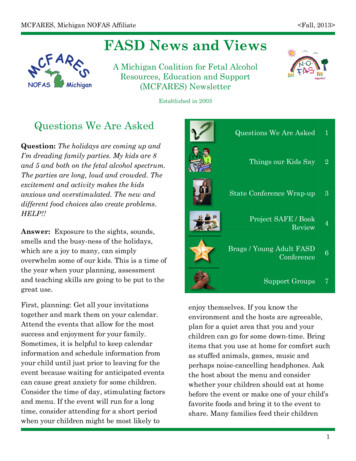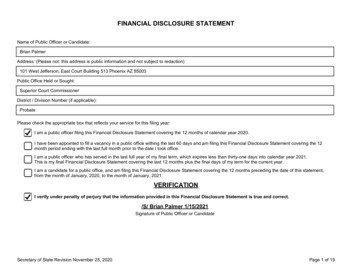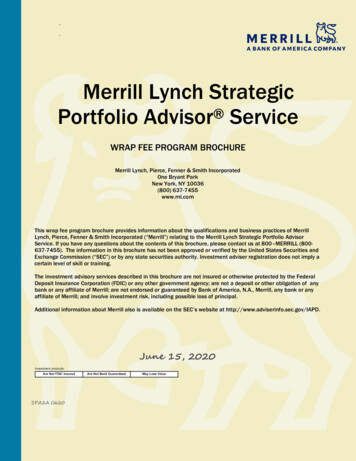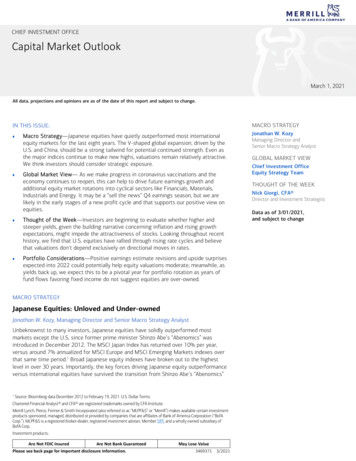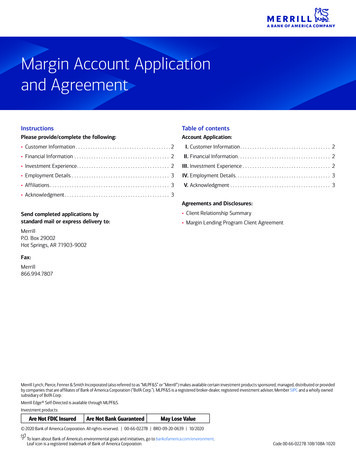
Transcription
Merrill Palmer Skillman Institute for Child & Family DevelopmentmpsiImPrintsMPSI is part of thE Division of Research at Wayne State University, Detroit MISPring 2015INSIDEThe Healing Powerof Storytellingpg. 3Dr. Bocknek’s TEDY project asks parents to do a drawing exercise with their two-year-old. Theteam is investigating why certain children grow-up resilient despite stressful events.GivingtheGift ofExperiencepg. 4Happiest Research on the BlockPediatrician Harvey Karp is the bestselling author of the Happiest Baby on theBlock, a modern-day classic that explainssimple, effective tools parents can use tohelp infants stop crying and tap into theirreflex to self-soothe.Erika Bocknek is a researcher and licensedmarriage and family therapist, poised tobecome MPSI’s newest faculty member inAugust through a joint appointment withthe College of Education.The two doctors intersected at MPSI lessthan a year ago when Dr. Karp discussedhis lastest book, Happiest Toddler on theBlock, at a professional training for theWoodward Early Childhood Consortium ofpreschools and daycares. As they spoke,a research project took form. They bothwanted to empirically validate the soothingsteps in the Happiest Baby book. “Parentsreally love that book,” Dr. Bocknek saidduring a recent interview, with her ownnewborn daughter sleeping peacefullynearby. “They feel empowered by it because the techniques are often immediatelyeffective. The baby stops crying.” Dr. Bocknek holds an infant mental health endorsement and cares deeply about the bondsformed between infants and caregivers. “Aparent is more likely to hold her baby whenshe feels competent to soothe her baby,which predicts stronger bonding,” she said.“This is so important and could lessen childabuse and neglect.”The suggestions in Dr. Karp’s book,specifically the Five Ss of swaddling, shushing, swinging, sucking and side/stomachpositioning, are based on the science ofnewborn development and are complementary to infant mental health scienceand practice. Validating their effectivenessis necessary for his approach to have widerimpact, possibly as an intervention pediatricians could teach new parents during anewborn wellness visit.See page 11SpecialFreerHouseSectionpg. 5The historic Freer House is home toMPSI faculty and staffStudent VolunteersLearn as They Give pg. 10October 7 & 8Explorations inDevelopment ConferenceRelational PlayTherapy for Toddlersand Preschoolerspg. 9Editor/Writer - CHERYL DEEPGraphic Designer - CATHERINE BLASIO
mpsiResearchNEWS & HONORSHard Work Acknowledged WSU’sprovost has recommended to the Board ofGovernors that Dr. Steven Ondersma bepromoted to full professor in August. He isworking to transform patient use of mHealthtechnology in the waiting room into a high-reach tool for integrating physical and behavioral health, increasing access to care, andestablishing rigorous benchmarks for key health outcomes.MPSI VolunteersCompetitive Award Laurel Hicks, acurrent predoctoral fellow, won a Blue CrossBlue Shield of Michigan student researchaward for her project, Improving MentalHealth, Birth and Maternal Outcomes in Detroit Mothers - A Mindfulness-Based Intervention. Laurel is pursuinga dual-title Ph.D. in Clinical Social Work and Infant Mental Health.Her primary research interest is mindfulness-based interventions toimprove mental health, and maternal and birth outcomes in pregnant women.MPSI Infant Mental Health group poses with Carolyn Dayton(center) holding award at MI-AIMH conference in Kalamazoo, MIInnovation and Dedication TheHiram E. Fitzgerald award is given to anemerging scholar committed to strengthening relationships between infants, toddlers and their families and enhancing theirquality of life through innovative research. Dr. Carolyn Dayton,MPSI’s associate director of Infant Mental Health won the 2015award. Her research targets early parenting processes with an innovative emphasis on fathering in urban settings, while her clinicalwork looks for biological and psychosocial risk and resilience factors that influence early parenting process and early child development. Of the four Fitzgerald awards to date, three have been toMPSI faculty specializing in Infant Mental Health.Top Fellow Former MPSI fellow AmyLoree accepted a position with the Interprofessional Advanced Fellowship in Addiction, jointly taught by faculty of YaleUniversity and the Veterans AdministrationConnecticut Healthcare System in West Haven, CT. This fellowship provides two years of post-residency, post-doctoral research,education, and clinical learning opportunities to eligible physiciansand associated health professionals.GIVING BACK Marguerite Carlton hasbeen named MPSI Senior Major Gift Officer. Marguerite’s 20 years of dedicationto Wayne State include lead developmentand administrative roles at WDET-FM, theSchool of Business Administration, and the School of Social Work.MPSI will share Marguerite’s fundraising talents with the LibrarySystem and the Institute of Gerontology. She’s completely comfortable grasping the complexities of three units to match theright donor with the right project.“It’s about telling our story,” she said. “We must communicatewhy our work matters, what makes it meaningful.” She is alreadyfamiliar with much of MPSI’s story through shared projects withthe College of Education, the College of Nursing, and the Schoolof Social Work. “Some people think fundraising is about numbers,but it’s the people behind those numbers that matter,” she said.“I enjoy building collaborations and connecting the dots. Oncepeople understand what we are trying to accomplish, I knowthey’ll want to help us get there.” To learn more about MPSI’sneeds and goals, contact Marguerite at margueritec@wayne.eduor call 313-664-2608.From Fellow to Tenure TrackMickey Sperlich, a fellow and the first social work graduate to receive her doctoratethrough MPSI’s dual title program in infantmental health, has taken a tenure track position at State University of New York (SUNY) in Buffalo. Her workhas centered on women’s physical and mental health and healthdisparities, and how trauma, posttraumatic stress, and other comorbid mental health disorders can affect pregnancy, birth, andearly mothering and attachment.Publication Kudos Predoctoral fellow Hilary Marusak’s paper, Childhoodtrauma exposure disrupts the automatic regulation of emotional processing was selectedfor publication in the peer reviewed Neuropsychopharmacology journal. She was also invited to attend theesteemed UCLA Neuroimaging Training Program Advanced Summer Course in 2015. She is pursuing a doctorate in translationalneuroscience.www.mpsi.wayne.edu2
OutreachmpsiThe Healing Power of Storytelling“It’s a bit of a drive.”That’s what the representative from the MichiganRoundtable for Diversity andInclusion said as she askedwhether the Healthier UrbanFamilies program could helpwith a training in late April.HUF’s Director BeverlyWeathington, LMSW, rarelysays no when a group needsher help. She gives dozensof trainings to parents, children and professionals everyyear at churches, schools,youth organizations andsupport groups mostly inand around Detroit.“When they told me theywould provide transportation, I figured they meantKeweenaw Bay Indian community member sharesher story. Photo courtesy The Mining Journalit was in Highland Park ormaybe Macomb County,”Native Americans needed to be acculturatedBev said with a smile. “Not the Upperto the majority race in the United States,”Peninsula.” After a ten-hour van ride, BevBev explained. This meant children werefound herself just south of Houghton at thepulled from their parents, some as youngHealing Stories on Racial Equity roundtableas 6, sent to a distant institution often withfor the Keweenaw Bay Indian Community.hundreds of other children, forbidden toRather than a traditional training, Bev hadspeak their native language or participatethe revered position of “listener” as 15 fein any native traditions, and taught basicmale members of the L’anse tribe met withdomestic skills to prepare them for menialher and members of the Michigan Roundjobs on graduation.table for Diversity and Inclusion, to tell their“They rarely saw their parents and whenstory. Though it wasn’t a typical training,they returned home for visits, they someshe soon felt the impact and almost mysticaltimes felt like strangers. Native childrenpower of this experience for speaker and liswere especially susceptible to diseases suchtener. “I would do it again, yes, absolutely,”as tuberculosis and measles in the largershe said.boarding schools, and outbreaks resultingThe women spoke of issues they face inin the loss of young lives were not uncomand out of the Native American community,mon. There could be emotional, physicaltheir pride and challenges. Many sufferand sexual abuse and no recourse,” Bevsevere bullying and bigotry when they leavesaid. “The experiences caused a disruptionthe reservation and venture into the nearbyto the parental/child bond and resulted intown. Several women were daughters ofgenerational trauma.” A large school in Harparents and grandparents who spent theirbor Springs, Michigan where many L’ansechildhood in boarding schools mandated bytribe children were boarded, finally closedMichigan and federal policy. “The philosoin 1983.phy in the mid-1900s was that children ofwww.mpsi.wayne.edu3The children of the NativeAmerican parents who grewup in boarding schools alsosuffered. The parents hadbeen raised in a non-nurturing environment, madeto feel ashamed of theirculture and themselves.They were unable to passdown native customs totheir children, because theydid not know them. Thestories Bev heard reflectedthese and other losses, andopened her eyes and heart.“I hadn’t known the extentof this trauma,” Bev said.There is power in tellingthe story, though, power inbeing acknowledged andheard even years after theevent. “The simple act oftelling can be very freeing,”Bev said. “I couldn’t make what happenedto these women any better. I wasn’t thereto console them, advise them, or counselthem. They didn’t want answers. I was anobjective and compassionate ear. Thesewomen wanted me to know what happened to them and that while they may stillstruggle because of it, they have a strengthand tenacity that is allowing them to reconnect and celebrate their heritage. That iswhat helps them. That’s the power of tellingthe story.”When the session ended, the tribe invitedBev and the group of listeners for dinnerand informed them that they would have achoice of walleye or trout. “Is there a fishstore nearby? I didn’t see one,” Bev asked.The fishermen laughed, grabbed somepoles and headed toward Lake Superior.“That was the freshest fish I ever ate,” Bevsaid, “but I took some teasing about the‘fish store.’” The entire experience was sopositive, she’s been invited to the tribe’sthree-day Pow Wow later this summer.Fresh fish included.
mpsiStewardshipGiving the Gift of Experienceusan Kesner and herbrother SeymourNayer attended MerrillPalmer’s preschool inthe ‘50s. Their parents were strongproponents of the program, and theschool experience had a lifelong impacton the entire family. When their motherCorinne Nayer passed away in 2013,nearly two dozen of her friends andfamily donated to MPSI in her memory.Today, Sue is a director at CopyrightClearance Center in Massachusetts, andSeymour is a partner with the law firmPlunkett Cooney in Bloomfield Hills,Michigan. They continue to give oftheir time and treasure to support ourInstitute.From Sue:SWhen my mother passed away twoand a half years ago, I knew immediately that I wanted to honor her memoryby contributing in some capacity toMerrill Palmer. My family has a longhistory with this special institution beginning in the ‘30s with my grandparents, andcontinuing to the present as my brotherSeymour (preschool class of ’59) serves onSue Kesner communes with horses, pigs and preschoolers during a day-long outing with the EarlyChildhood Center.the MPSI Board. In between, there werethree MP alumni (my uncle in one of thefirst classes, myself in the class of ’56 andmy brother). For my mother, Merrill Palmerrepresented the convergence of threethings she cared about deeply: Detroit,superior early childhood education, anda unique community.“A year ago, I met with the gift officerfor MPSI to discuss a donation thatwould have direct impact on the youngstudents of the Early Childhood Center.When she suggested funding the annualReal Life Camp and Farm field trip for90 preschoolers and their parents, I wasdelighted. When she invited me to comealong I jumped at the opportunity.“A few months later, on a beautifulMay day in Detroit, my brother and Ipacked our lunches and boarded thebuses with about 200 children, parentsand the wonderful MPSI staff. Fortyminutes later we rolled into the farmand the fun began – horseback riding,feeding baby animals and hay rides.The farm staff was kind, careful andexpert teachers. Seymour enjoyed theday, too. ‘What I liked most was seeingthe children interacting with their parents,both at the farm and on the bus ride,’ hesaid. ‘I noticed many dads were involved,Considering a donation? Call Marguerite Carlton at 313-664-26084See back page
The Freer HouseAn International Landmark . . . A World Class Lecture Series71 East Ferry, Detroit, Michigan 48202 313-664-2500Hecker Mansion Joins Freer House as Wayne State TreasureCol. Frank J. Hecker was president and Charles L. Freer vice president of the Michigan Peninsular Car Company,a railroad freight car manufacturer. Hecker and Freer built their remarkable homes next door to each other in 1890-92.Wayne State purchased the Hecker Mansion in April and will take occupancy this fall.A Collaboration of Artists and Friends: the Hecker TriptychThe Hecker triptych is a recent addition to the DIA’s Inside Out program, ondisplay between the Hecker and FreerHouses on E. Ferry, from April throughJuly 2015.The triptych commissioned in 1893 byCol. Frank J. Hecker (1846-1927) for hishome on Woodward Avenue was the result of Hecker’s close friendship with hisbusiness partner and next-door neighborCharles Lang Freer (1854-1919), and theartistic collaboration of painters ThomasW. Dewing and Dwight W. Tryon. Heckerdesired paintings similar to works beingcreated by Dewing and Tryon for Freer’shome. The result, Spring, Summer, Autumn (1893), originally graced the wallsof the Hecker’s music room and today isa highlight of the DIA’s American art collection.DIA INSIDE OUT Brings reproductions ofgreat treasures from the Detroit Instituteof Arts into your community.Discover them all around town.Standing next to the DIA’sInside Out of the HeckerTriptych are (left to right):Freer House Director WilliamColburn, Attorney and Heckerscholar J. Douglas Peters,Senior Project Administratorat Wayne State’s Office ofEconomic Development JeriStroupe, Freer House internBuddy Engelhart, Freer Houseresearch assistant MeghanUrisko, and Freer House internJames K. Miller.Faculty and staff of MPSI have their offices in the former home of Detroit industrialist and art collector, Charles Lang Freer. The22-room, Shingle-style home was built in 1892 and designed by architect Wilson Eyre, Jr. Freer displayed his large collection ofpaintings and porcelain in the light-filled rooms.
A Quarter Century Labor of Love:Hecker Mansion Restorationby William Colburn, Director, The Freer Househouse. The buildingThe Freer House onwas then sold to theE. Ferry St. and the adSmiley Brothers Musicjacent Hecker House onCompany and funcWoodward Ave. have ationed as a splendidlong history in comshowroom for pianomon. The homes wereand organ retail sales.built between 1890-92In 1991, the Heckerby Charles Lang FreerHouse was purchasedand Col. Frank Heckerby Charfoos and Chriswho were close friends,tensen P.C. law firmbusiness partners andwhich invested considnext door neighbors.erable effort, under theFreer and Heckerdirection of principalbought their lots onattorney J. Douglasthe same day in 1888Peters, to beautifully(Hecker’s lot on WoodDoug Peters, former co-owner of therestore this magnifiward cost an astoundHecker House, above, and left at workhand-framing a giclee painting that nowcent structure. In lateing 30,000). Freerhangs in the Freer House.2014, WSU bought theassisted Hecker with theHecker House and willdesign of his home bymove staff into the building this fall.selecting the architect Louis Kamper, whoThe Freer House salutes Doug Peters forcreated a limestone mansion in the Frenchhis outstanding role, together with DavidChateauesque style. Freer began construcChristensen, in leading the exceptionaltion of his own house soon thereafter andrestoration of the historic Hecker House.had it designed in the simpler, yet sophisDoug has served for many years on the Freticated Shingle style, by architect Wilsoner House board and played a leading roleEyre, Jr. of Philadelphia.with many successful projects, including theThe Hecker and Freer houses were twoinstallation of 11 ‘giclee’ reproductions ofof the finest private residences in Michipaintings originally commissioned by Freergan. Following Freer’s death in 1919 andfor the interior of the house. Doug also hasHecker’s in 1927, the homes took differentbeen instrumental in guiding and advisingpaths. The Freer House was sold to themultiple maintenance and restoration projMerrill Palmer School in 1920/21 and conects at the Freer House. We are indebted totinues to be used for educational purposeshim for his extraordinary vision and supportas MPSI. The Freer House membership orand look forward to his continued participaganization of MPSI raises public awarenesstion as he retires from a distinguished lawof the significance of this historic buildingcareer and continues his second career asand works to support its maintenance andan accomplished painter and artist.restoration.In March, the Freer House commissionedThe Hecker family continued to ownrenowned architectural photographer, Alexthe Hecker House until 1947, engagingVertikoff, who previously photographeda young couple, the Andersons, to operthe Freer House, to document the interiorate the building as a high-end boardingof the Hecker House to record the superbrestoration work during Charfoos and Christensen’s 24 years of ownership. A selectionof these beautiful photos is shown here.
2015 Hecker Mansion photosby Alexander Vertikoff
71 East Ferry, Detroit, MI 48202 313-664-2500Visitors Connectwith Freer HousePast, Presentand FutureFreer House hosts hundreds of visitors ayear. Its 350 members account for many ofthe visits, often at the post-reception of aguest lecture at the Detroit Institute of Arts.But throughout the year, a few dozen otherinterested folks also drop by. These uniquevisitors include alums of the Merrill Palmernursery school, former Ferry Street neighbors curious about changes to the area,and community leaders interested in Freer’scontributions to Asian and Islamic art. A fewof our recent guests:1 Alan Fern is doubly connected to FreerHouse. He attended the Merrill Palmer Institute nursery school in the 1930s. “I even remember where I used to hang up my coat,”he said, “and sitting in window seats.” Helater became director of the National Portrait Gallery at the Smithsonian Institution,where the Peacock Room (formerly ownedby Charles Freer) is now housed. He andhis wife Lois flew from Maryland in June toattend a Detroit conference of art museumdirectors and spent an afternoon at FreerHouse. “When we visit the Freer Gallery atthe Smithsonian, Alan reminds me that hefinger-painted in the space that had housedthe Peacock Room,” his wife Lois said. Theyboth “loved” reminiscing and seeing howthe house is gradually being restored to acommunity treasure.2 The Freer House was honored with avisit in early June by Takashi Omitsu, president, IMRA America, Inc. and his administration coordinator and assistant, KazuoIshikawa. In his role as an executive advisorto the Japan Business Society of Detroit,Takashi was interested in seeing the FreerHouse and learning more about its significant historical connections to Freer, Detroit,and the art and culture of Japan. The tourwas aided by Freer House member andvolunteer, Hiroko Lancour, who has doneBelow: Alan Fern seated in Freer Housecourtyard where he played as apreschooler.Below L-R: William Colburn, Takashi Omitsu, Kazuo Ishikawa,Hiroko Lancour.123Above L-R: From the Historic Ford Estates: MarkHeppner, VP historic resources; Kathleen Mullins,president and CEO; Megan Wood, assoc. VPeducation and visitor experienceconsiderable research on Freer’s importantconnections to Japan.3 Executive staff members, includingPresident and CEO Kathleen Mullins, of theHistoric Ford Estates (Eleanor and EdselFord House and Henry Ford Fairlane Estate),recently toured the Freer and Heckerhouses to learn more about these importanthistoric landmarks in Detroit and to shareideas and resources for preservation andrestoration. The group saw archival photosand documentation of the significant roleof Eleanor Ford in the development of theMerrill-Palmer Institute during her 50 yearsof service and leadership on the board from1926 to 1976.4Above: Lydia Easley seated in Freer House drawingroom.4 Lydia Easley spent her first 12 years inthe Hecker House, the turreted mansionnext door to Freer House that was a boarding house run by her parents at the time.She was an only child but shared the housewith 65 boarders. She attended MPI’s nursery school, not just because it was convenient. “My mother knew it was very highlythought of,” Lydia said when she visitedfrom Washington in March. “The schoolwas involved with mother and daddy rightfrom when I was born.” Her developmentat MPI was immortalized as a case study in a1959 book chapter on General Principles ofDevelopment.The Freer House is home to Merrill Palmer Skillman Institute at Wayne State University
TrainingmpsiResilience in Urban Children: A New Way to TrainMPSI recently received a grant fromWSU’s Graduate School to enhance graduate level training for careers that promotecompetence and resilience in urbanchildren. The award provides stipends andtuition for four graduate research assistantsto receive mentorship and guidance froma team of federally funded researchers whorepresent multiple disciplines including psychiatry, pediatrics, social work, psychologyand infant mental health. MPSI was the onlysocial sciences program chosen.MPSI’s current training program complements work in students’ home departmentswith individualized training plans in developmental science to strengthen their pro-fessional skills so they can make meaningfulcontributions to research on children inchallenging environments. “The new grantsharpens the training focus by combiningMPSI’s interest in promoting positive youthand family development with models of riskfor a more holistic approach,” said ValerieSimon, Ph.D., program leader for the grantand jointly appointed faculty in MPSI andPsychology. The students chosen will createan individualized training plan with theirmentoring team that includes didactics,community engagement, cross-disciplineresearch, and core thematic content.“Competence and Resilience amongUrban Infants, Children, and Adolescents“More people from more disciplineswill be talking and working together.-Dr. Simonduring Critical Developmental Transitions”is the core theme. Training topics includebio-behavioral stress, adverse childhoodexperiences, core developmental competencies, developmental research methods,and the role of socio-cultural factors indevelopmental experiences. For years,MPSI’s pre-doctoral training has preparedemerging professionals from multiple disciplines for careers that use developmentalscience to promote the well-being of urbanchildren and families. So MPSI was wellequipped to take this perspective on theimpact of adverse childhood experiences ondevelopment and use it to foster resilienceand developmental competencies in urbanchildren.As students and faculty mentors engagefrom a range of disciplines, benefits to bothgroups emerge. “A trainee might use datasets from their home field, such as psychology that focuses on individual differences,to collaborate on a paper with a facultymentor from social work to consider howSee back pageOnline registration mid JulympsiFor more information call Bev Weathington at 313-664-2526Who Will BenefitLocationRegistration Cost IncludesNurses, social workers, andother professionals workingwith infants and familiesWSU Oakland Center33773 W. Twelve Mile Rd.Farmington Hills, Mi, 48331continental breakfast and CEs. Lunch not includedHosted By - The MPSI Healthier Urban Families Outreach Program & Infant Mental Health Program atWayne State University, and the Michigan Association for Infant Mental Health.9
mpsiEducationStudent Volunteers Learn as They GiveWhat has 134 opensubjects, scoring selfarms, enviable brainreport measures andpower, 67 compasother skills.” Studentssionate hearts, andbuild strong mentoran infinite supply ofing relationships withgenerosity?faculty; graduateThe young menstudents can also menand women who filltor younger volunteersMPSI’s research labs asand learn leadershipvolunteers on an arrayskills. Faculty membersof important projectsget high quality helpto improve the wellon a tight researchbeing of children andbudget. VolunteersFateimah photofamilies.bring fresh perspecThese special 67,tives, too, that canFatimah Alismail, a volunteer in Dr. Stack’s lab, explains her research at the May Michiganmost of them underimprove processes andAssociation for Infant Mental Health conference. Fatimah is a doctoral student in schoolgraduates or recentproblem-solving.psychology and an “honorary” student in the Infant Mental Health dual-title program. Shehas completed all the classes and is writing a dissertation related to infant mental health.graduates of Wayne“We are flatteredState, are the unthat so many studentspaid army that keeps MPSI’s researchvolunteer to be a part of the MPSItions.moving forward. They hail from suchexperience,” Dr. Lichtenberg, MPSI“Volunteering is mutually beneficial,” saiddisciplines as neuroscience, psychology,director, said. “Our faculty works hardMPSI Infant Mental Health Director Annsocial work and medicine. They collectto immerse them in work that is meanStacks whose lab is home to 10 volunteers.and analyze data, recruit subjects,ingful and educational. We accomplish“Students get experience in all aspects ofpresent research posters, win academicmuch more by teaming with talentedresearch and get to practice what they learnawards, and even co-author publicavolunteers.”in class: interviewing, protection of humanTo learn more about our labs visit: http://mpsi.wayne.edu/research/research labs.phpwww.mpsi.wayne.edu10
ReseachHappiest from page 1Interventions by the BookDr. Bocknek’s team, in partnership withDr. Deepak Kamat, vice chief for medicaleducation at the Detroit Children’s Hospital,created a project to test the effectiveness ofthe Five Ss. New parents would receive acopy of the book, a CD of calming soundswhite noise, a swaddling blanket, a bookmark of the Five Ss, and a brief training.They would complete a pre- and postsurvey and receive personalized texts asreminders and support. When the infant isabout four months old, parents would takeone more survey.Positive, simple interventions to strengthen the bond between parent and child arean overarching goal of Dr. Bocknek and herresearch. She hopes her career course willmake a meaningful contribution to improving clinical practice with children and theirfamilies. “All of my work has been focusedon vulnerable children, children living inpoverty or with social issues that causea separation or impairment in the earlyparent-child relationship, like incarceration.” She has always cared about the childwho is “double traumatized” by povertyand violence. “These vulnerable childrenneed close relationships with nurturingadult caregivers the most.”Her appointment at MPSI provides a collegial team of supportive faculty members.“They have enriched the way I think aboutresearch problems,” Dr. Bocknek said. TheHappiest Baby research project uses textmessaging to communicate with parents after the initial training, something she wouldnot have tried if not for MPSI’s Dr. StevenOndersma. “For years, Steve has been usingtechnology in his interventions with greatsuccess,” Dr. Bocknek said. He convincedher that a text or other technological adaptation can be less intrusive and more effective than traditional parenting interventionslike group psychoeducation, especially tothe parent of an infant. “That’s a greatexample of interdisciplinary collaboration. A“Parents really lovethat book. It’s becomethe classic of ourgeneration.Erika Bocknektechnique that I could not have imagined ayear ago is now one of my best opportunities for improving clinical interventions withparents.”What Builds Resilience?Dr. Bocknek’s team is researchingresilience in another project called TEDY,for Toddlers’ Emotional Development inYoung Families, a partnership with the ArabAmerican Chaldean Council WIC (Special Supplemental Nutrition Program forWomen, Infants, and Children). Levels ofwww.mpsi.wayne.edu11mpsicommunity violence can be high in urbancommunities, and Dr. Bocknek is demonstrating in her research that many adults inyoung Detroit families suffer from posttraumatic stress syndrome. Some -- but notall -- children exposed to violence have poorsocial-emotional development and schooloutcomes. What of the children whodevelop normally despite the violence, theresilient group? Dr. Bocknek wants to know“what else is going on in those families?Are family processes like daily routines andmeaningful rituals protecting the childrenfrom the chaos outside the home?”The TEDY team observes and interviewsthe 2-year-olds and their families, and monitors heart rate and oxytocin levels to betterunderstand the keys to resilience. Fif
his lastest book, Happiest Toddler on the Block, at a professional training for the Woodward Early Childhood Consortium of preschools and daycares. as they spoke, a research project took form. they both wanted to empirically validate the soothing steps in the Happiest Baby

